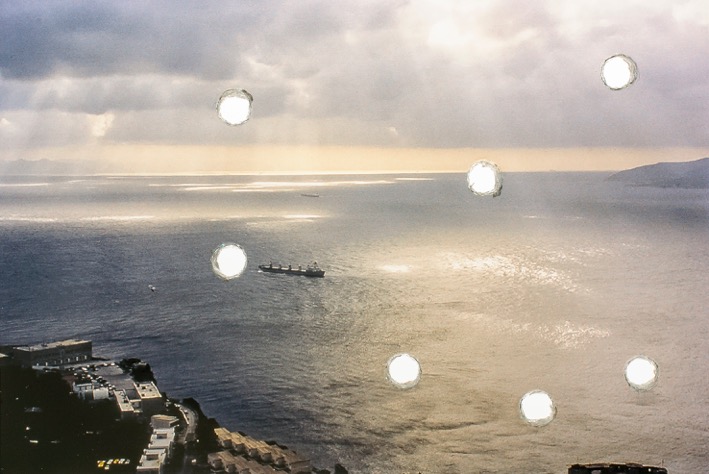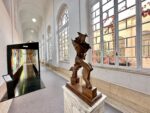Runo Lagomarsino – West is everywhere you look

Il lavoro di Runo Lagomarsino (Lund, Svezia 1977, vive e lavora a San Paolo, Brasile e Malmö, Svezia) è una ricerca finalizzata a indagare i modelli storiografici, geografici e matematici che hanno informato il controllo coloniale del mondo da parte della modernità occidentale.
Comunicato stampa
“Il lavoro di Runo Lagomarsino (Lund, Svezia 1977, vive e lavora a San Paolo, Brasile e Malmö, Svezia) è una ricerca finalizzata a indagare i modelli storiografici, geografici e matematici che hanno informato il controllo coloniale del mondo da parte della modernità occidentale. Come si articola il rapporto tra l’invenzione della descrizione storico-geografica del pianeta ad opera della ragione europea e il dominio politico di esso? Le ricerche di Lagomarsino provano a rispondere a tale quesito muovendo da una prospettiva di analisi culturale comparata, suggerendo la possibilità di nuove forme di interpretazione culturale, alternative e oppositive rispetto a quelle sancite e trasmesse dalla ragione moderna europea. “
Con queste parole di Luigi Fassi si introduce la figura di Runo Lagomarsino in occasione della la sua prima personale da Francesca Minini. Il progetto dell’artista si apre con un segnale/cartello, Deportation regime che esplicita subito il climax dell’intera mostra. Il riferimento ad Agamben e la sua nozione di sovranità del potere è per l’artista fondamentale, e come tale potere sia in grado di far ripensare le nostre categorie politiche. L’homo sacer nel diritto romano arcaico era colui che aveva la libertà di uccidere senza essere accusato di omicidio e quindi non essere condannato a morte. Questa figura del diritto ha fatto sì che possa esistere una vita uccidibile da una parte e una vita sacra e insacrificabile dall’altra. Da allora la vita è diventata qualcosa che appartiene alla politica, una posta in gioco; possiamo allora parlare di biopolitica. Seguendo il filo rosso della storia, percorrendo con Agamben il suo testo Homo Sacer, si possono cercare di decifrare gli enigmi posti dalle opere di Lagomarsino e affrontare i totalitarismi e le nefandezze - prima di tutto il fascismo e il nazismo - che lo scorso secolo ha proposto alla storia. Quello che il filosofo italiano ha descritto e definito nel campo di concentramento, ossia il paradigma biopolitico nascosto della modernità - in cui città e casa sono diventate indiscernibili - e la possibilità di distinguere tra il nostro corpo biologico e il nostro corpo politico ci è stato tolto una volta per tutte.
Oggi, senza eccedere, possiamo vederlo in un ambito, non follemente sistematizzato come erano allora i lager ma altrettanto crudele, in ciò che sta accadendo nel Mediterraneo. Le mappe appese, della seconda sala, fluttuanti, sottosopra rispetto alla convenzionale lettura che ne possiamo fare, quasi una meccanica scenografia barocca ribaltata, ci mettono nell’impossibilità di stabilire dei confini, di leggere una carta come convenzione spazio/territoriale e anche spazio/temporale. Il titolo della mostra nasce proprio da questo lavoro. L’Occidente è ovunque guardi, West is everywhere you look.
Il Mar Mediterraneo non cessa e non ha mai cessato di essere il crocevia di mille accadimenti. Spazio da declinare al plurale all’interno di un’identità europea e mediterranea per sua natura molteplice. Non è possibile concepire sul piano sincronico e diacronico la realtà geopolitica come entità bloccata e univocamente fissata. Tali cambiamenti e mutazioni hanno generato nei secoli scorsi conflitti interni a tutte le culture mediterranee che tuttora influenzano e determinano il rapporto tra le genti. Il linguaggio, la parola scritta come convenzione, come strumento di interazione e pacificazione, da sempre convive con le culture del Mare Nostrum, titolo di un’altra opera in mostra. La pluralità delle genti e la pluralità delle culture era normale fin dal basso medioevo. In Sicilia gli ebrei usavano l’arabo come lingua corrente, oltre al siciliano, e destinavano l’ebraico solo alla lettura dei testi sacri; in seguito tale sincretismo è stato smarrito per assecondare conflitti e persecuzioni. Mare Nostrum vuol dire allora anche memorie non riconciliate, significa anche paura reciproca che risale a più di 500 anni fa che ha subito tentativi di pacificazione del tutto di natura politica e raramente culturale. Tale timore è anche sugellato però da grande curiosità reciproca, da volontaria e necessaria ricerca di condivisione. Parlando di Mediterraneo come non pensare allora a Braudel e alla sua idea di mediterraneo come luogo della prossimità, concetto questo che ha incrementato anche l’idea di un luogo sempre più piccolo, una vera zona di confine tra due mondi, oggi molteplici mondi. Dai Balcani all’Asia Minore, dalla Penisola Iberica all’Africa del Nord, il mare nostrum costituisce da sempre un confine che allo stesso tempo è ostacolo e legame tra le parti. Clima, natura, cibo, modi di vivere, religioni cambiano, si mescolano e si ricompongono, a seconda che si trovino a Nord o a Sud del mare. Una vera e propria sintassi mediterranea, articolata grazie ad una gramamtica interna, con la quale possiamo vedere, sentire, ascoltare questo mare. Ecco che le ottanta immagini costruite da Lagomarsino vanno a definire un racconto del nostro mare; una sequenza di diapositive ci permette di leggere un’interezza che lentamente si dissolve lasciando spazio ad un buco che risucchia il Mediterraneo facendolo scomparire definitivamente. Con esso scomparirebbe anche la millenaria civiltà che ha definito e costruito il progredire del mondo e della razza umana.
Alberto Salvadori
“The work of Runo Lagomarsino (b. 1977 in Lund, Sweden, based in São Paulo, Brazil and Malmö, Sweden) investigates the historiographic, geographic and mathematic models that informed the colonial domination of the world by Western modernity. How can one trace the relationship between the historical and geographic methods of describing the planet that were devised by European reason and the political control of that planet? Lagomarsino’s practice attempts to answer this question, setting out from a perspective of comparative cultural analysis and suggesting new, alternative forms of cultural interpretation that stand in contrast with those established and passed down by modern European thought.”
This introduction by Luigi Fassi may help us better understand the figure of Runo Lagomarsino on the occasion of his first solo show at Francesca Minini. The project opens with a sign, Deportation Regime, which immediately points to the fulcrum of the entire show. The reference to Agamben—his notion of sovereign power, and how this power is capable of reshaping our political categories—is a pivotal one for the artist. In ancient Roman law, a homo sacer was a man that could kill anyone without being accused of murder, hence without being condemned to death. This figure introduced the legal concept of a life that on the one hand could be taken, but on the other hand was sacred and could not be ritually sacrificed. From that point on, life became something that belonged to politics, a crucial issue; for this reason, one can speak of “biopolitics”. Following this historical thread and the line of thought that unfolds through Agamben’s book Homo Sacer, we can try to decipher the riddles posed by Lagomarsino’s works and attempt to fathom the crimes and totalitarian regimes—first and foremost, Fascism and Nazism—that the twentieth century contributed to history. In other words, what the Italian philosopher described and defined as the hidden biopolitical paradigm of modernity, the concentration camp - where city and home have become indistinguishable - and the possibility of discriminating between our biological body and our political body has been taken away for good.
Today, without exaggeration, this can be seen in a sphere not as rabidly organized as the Nazi camps, but every bit as cruel: what is happening in the Mediterranean. The maps that hang in the second room—floating there, so far from any customary interpretation of them, like some upturned Baroque stage machine—put us in a position where it is impossible to establish boundaries, to read a map as a spatial/territorial and spatial/temporal convention. The title of the exhibiton is taken form the title of this work: West Is Everywhere You Look.
The Mediterranean has never ceased to be the crossroads of a thousand events. A space that must be spoken of in the plural, within a European and Mediterranean identity that is multiple by nature. It is impossible to think of geopolitical reality at the synchronic or diachronic level as an entity that is frozen and univocally fixed in place. All of these changes and mutations, over the past few centuries, have generated conflicts within every Mediterranean culture that still influence and shape the relationship between different populations. Language, the written word, as a convention, a tool of interaction and pacification, has always played a key role in the cultures of Mare Nostrum, the title of another work in the show. The plurality of populations and plurality of cultures was normal up until the Late Middle Ages. In Sicily, Jews used Arabic as an everyday language, along with Sicilian, and Hebrew was only for reading the sacred texts; later, this syncretism was lost in response to conflicts and persecution. Mare Nostrum therefore also implies unreconciled memories; it signifies a reciprocal fear, dating back over half a millennium, that has witnessed attempts at pacification of an entirely political and rarely cultural nature. This fear is also marked, however, by great reciprocal curiosity, a voluntary and necessary quest to find shared ground. And so in speaking of the Mediterranean, how could one help but think of Braudel and his concept of it as a locus of proximity, a concept that has also bolstered the idea of an ever smaller place, a true borderland between two worlds, which have come to be multiple worlds. From the Balkans to Asia Minor, and from the Iberian Peninsula to North Africa, mare nostrum has always been a boundary that is both obstacle and bridge. The climate, natural environment, food, lifestyles and religions change, blend together and are recomposed, depending on whether one is north or south of the sea. A full-fledged Mediterranean syntax, built around a grammar all its own, which allows us to see, hear, listen to this body of water. So the eighty images created by Lagomarsino help tell a tale of our sea; a sequence of slides offers the vision of a whole that slowly dissolves and gives way to a hole, sucking in the Mediterranean until it definitively disappears. And what can be imagined vanishing along with it is the millennia-old civilization that defined and constructed the progress of the world and of the human race.
Alberto Salvadori



